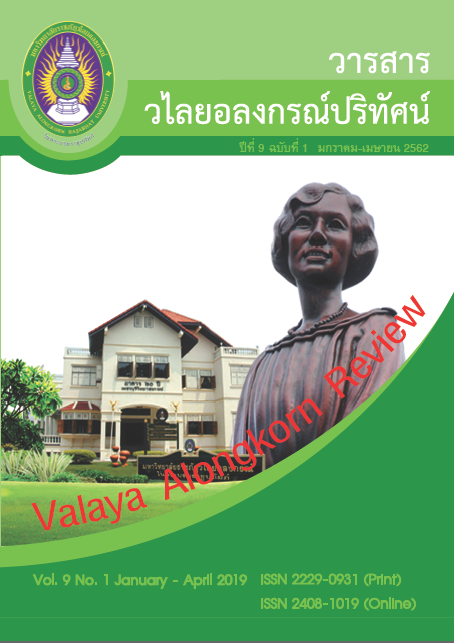สงกรานต์: ปริศนาธรรมแห่งตำนาน
คำสำคัญ:
สงกรานต์, ปริศนาธรรม, ประเพณี, กตัญญูกตเวทีบทคัดย่อ
ในเทศกาลวันสงกรานต์หรือวันขึ้นปีใหม่ไทย มีเรื่องเล่าเป็นตำนานสงกรานต์ที่มีคติแฝงเป็นเนื้อในไว้ให้ได้เรียนรู้เรื่องราวชีวิตของคนที่อยู่ร่วมกันในสังคมผ่านตัวละครและกิจกรรมซึ่งสามารถจำแนกออกเป็นบุคลาธิษฐานและธรรมาธิษฐานดังนี้ ธรรมบาลกุมาร คือเด็กมีความเป็นธรรมชาติ ที่บริสุทธิ์ ที่ผู้ใหญ่ควรให้ความคุ้มครอง ท้าวกบิลพรหม คือ ผู้ใหญ่ ผู้สูงอายุ หรือพรหมวิหารธรรม 4 ประการ ต้นตาล คือ ร่างกายที่ประกอบด้วยธาตุ 6 ประการ นกอินทรีย์ตัวผู้ตัวเมีย คืออินทรีย์ภายนอกกับภายใน 12 ประการ ปัญหา 3 ข้อ 1) เวลาเช้า ราศีอยู่ที่หน้า ได้แก่หน้านอกหน้าใน และหน้าที่ 2) เวลาเที่ยง ราศีอยู่ที่อก ได้แก่จิตใจอันเป็นสิ่งสำคัญของชีวิตที่ต้องเที่ยงธรรมเป็นกลาง 3) เวลาเย็น ราศีอยู่ที่เท้า ได้แก่จุดยืน คือสติปัฏฐาน ศีรษะ คือความคิดความเห็น ได้แก่ทิฐิ พาน คือกฎระเบียบของสังคมได้แก่สติปัญญา เขาพระสุเมรุ คือบุญคุณของบิดามารดา การแห่เวียนสามรอบ คือ วัฏฏะ 3 ได้แก่ กิเลส กรรม วิบาก นางสงกรานต์ คือ บุตรธิดาที่ต้องตอบแทนคุณบิดามารดา ทางกาย ทางใจ และทางทิฐิ น้ำ เป็นสิ่งแทนคุณธรรมหลายประการ เช่น ความอ่อนน้อมถ่อมตน ความสามัคคี ความซื่อตรง เป็นต้น สังคมต้องมีน้ำใจ สาด ราด รดน้ำธรรมให้แก่กัน เจดีย์ทราย คือ โลกุตตรธรรม และ ธง คือ พระนิพพาน
เอกสารอ้างอิง
คม ชัด ลึก. (2560). ภาพชุด วันครอบครัวรดน้ำดำหัวผู้สูงอายุ. [ออนไลน์], เข้าถึงได้จาก: http://www.komchadluek.net/news/regional/271595 (2561, 1 พฤศจิกายน).
จ. เปรียญ (นามแฝง). (2525). ประเพณีพิธีมงคลของไทย. กรุงเทพฯ: ธรรมบรรณาคาร.
ประปาไทยดอดคอม. (2561). น้ำกับบทบาทในพิธีกรรมของไทย. [ออนไลน์], เข้าถึงได้จาก: http://202.129.59.73/tn/March55/water5.htm (2561, 3 พฤศจิกายน).
พระพรหมคุณาภรณ์ (ป.อ.ปยุตฺโต). (2553). พจนานุกรมพุทธศาสตร์ ฉบับประมวลธรรม. (พิมพ์ครั้งที่ 19). นนทบุรี: เอส อาร์ พริ้นติ้ง แมส โปรดักส์.
พระศรีสุทธิพงศ์ (สมส่วน). (2560). พระเจดีย์: การบูชาในพระพุทธศาสนา. มจร พุทธปัญญาปริทรรศน์. 2(1), (มกราคม-มิถุนายน 2560).
ภิกขุโพธิ์ แสนยานุภาพ. (2520). ชุมนุมปริศนาธรรมจากพิธีทำบุญต่าง ๆ. กรุงเทพฯ: ธรรมบูชา.
มหาจุฬาลงกรณราชวิทยาลัย. (2539). พระไตรปิฎกภาษาไทย ฉบับมหาจุฬาลงกรณราชวิทยาลัย. กรุงเทพฯ: มหาวิทยาลัยมหาจุฬาลงกรณราชวิทยาลัย.
ราชบัณฑิตยสถาน. (2546). พจนานุกรรม ฉบับราชบัณฑิตยสถาน พ.ศ. ๒๕๔๒. กรุงเทพฯ: ศิริวัฒนาอินเตอร์พริ้นท์.
สุเมธ เมธาวิทยกุล. (2532). สังกัปพิธีกรรม. กรุงเทพฯ: สำนักพิมพ์โอเดียนสโตร์.
อุระคินทร์ วิริยะบูรณะ และคณะ. (ม.ป.ป.). พรหมชาติ ฉบับหลวง. กรุงเทพฯ: สำนักงาน ลูก ส. ธรรมภักดี.
ดาวน์โหลด
เผยแพร่แล้ว
รูปแบบการอ้างอิง
ฉบับ
ประเภทบทความ
สัญญาอนุญาต
ข้อความที่ปรากฏในบทความแต่ละเรื่องในวารสารวไลยอลงกรณ์ปริทัศน์ เป็นความคิดเห็นของผู้นิพนธ์แต่ละท่าน มิใช่เป็นทัศนะและมิใช่ความรับผิดชอบของกองบรรณาธิการจัดทำวารสาร และ
มหาวิทยาลัยราชภัฏวไลยอลงกรณ์ ในพระบรมราชูปถัมภ์


